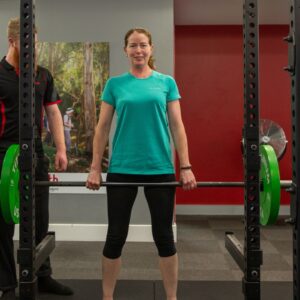Strength Training for Osteoporosis
Osteoporosis is a disease characterized by low bone mass and structural deterioration of bone tissue, leading to an increased risk of fractures (Wright et al., 2014). Strength training exercises can be an effective way to prevent and treat osteoporosis. Strength training applies force to the bones, which provides a stimulus for new bone formation (Howe, T.E., et al., 2011). This helps strengthen and thicken bones, making them more resistant to fractures.
Some of the key benefits of strength training for osteoporosis include improved bone mineral density, improved muscle strength, better posture and balance, and reduced risk of falls and fractures (Marques et al., 2017). Strength training triggers the body to release compounds that promote bone growth, including growth hormone and testosterone. It also stimulates osteoblasts, which are cells that form new bone tissue. Over time, regular strength training can lead to significant improvements in bone mineral density.
When designing a strength training program for osteoporosis, it is important to do weight-bearing and resistance exercises that target all the major muscle and bone groups. Examples include squats, lunges, chest presses, lateral raises, bicep curls, and calf raises using weights, resistance bands, or body weight (Giangregorio et al., 2015). Proper form and gradually increasing intensity and duration are key to providing an effective stimulus without risking injury. Most experts recommend strength training 2-3 times per week for people with osteoporosis, in addition to getting adequate calcium and vitamin D (Howe, T.E., et al., 2011).
With clinician guidance and proper precautions, strength training can be a safe and effective way to manage osteoporosis. The stimulus to bone tissue helps rebuild strength and prevent fractures. Strength training also provides many secondary benefits like better balance and posture. Along with medication and diet, it can be a key component of an osteoporosis treatment plan.
References:
Wright, N. C., Looker, A. C., Saag, K. G., Curtis, J. R., Delzell, E. S., Randall, S., & Dawson-Hughes, B. (2014). The Recent Prevalence of Osteoporosis and Low Bone Mass in the United States Based on Bone Mineral Density at the Femoral Neck or Lumbar Spine. Journal of Bone and Mineral Research, 29(11), 2520–2526. https://doi.org/10.1002/jbmr.2269
Marques, E.A., Mota, J., Machado, L., et al. (2017). Multicomponent exercise program improves physical functioning and reduces falls in older adults with osteoporosis: A randomized controlled trial. Archives of Physical Medicine and Rehabilitation, 98(8), 1608-1614. https://doi.org/10.1016/j.apmr.2017.03.029
Giangregorio, L. M., McGill, S., Wark, J. D., Laprade, J., Heinonen, A., Ashe, M. C., MacIntyre, N. J., Cheung, A. M., Shipp, K., Keller, H., Jain, R., & Papaioannou, A. (2015). Too Fit To Fracture: outcomes of a Delphi consensus process on physical activity and exercise recommendations for adults with osteoporosis with or without vertebral fractures. Osteoporosis International : A Journal Established as Result of Cooperation between the European Foundation for Osteoporosis and the National Osteoporosis Foundation of the USA, 26(3), 891–910. https://doi.org/10.1007/s00198-014-2881-4
Howe, T. E., Shea, B., Dawson, L. J., Downie, F., Murray, A., Ross, C., Harbour, R. T., Caldwell, L. M., & Creed, G. (2011). Exercise for preventing and treating osteoporosis in postmenopausal women. Cochrane Database of Systematic Reviews, 7. https://doi.org/10.1002/14651858.cd000333.pub2
Do you have any questions?
Call us on (03) 9857 0644 or (07) 3505 1494 (Paddington)
Email us at admin@mdhealth.com.au
Check out our other blog posts here
Our clinical staff would be happy to have chat if you have any questions.
Take the first step to a healthier you!
Would you prefer for someone to contact you regarding booking your Initial Physiotherapy appointment, Initial Exercise Physiology, Initial Osteopathy session or FREE Full Body Assessment*?
Or do you have any other enquiry about our services at MD Health?
Please fill in this form and someone from MD Health will be in touch with you soon.
Alternatively please call us on 03 9857 0644 (Kew East), 03 9842 6696 (Templestowe), 03 8683 9442 (Carlton North) or 07 3505 1494 (Paddington) to book now!
*Please note only the Full Body Assessment is a FREE service. The Full Body Assessment is for new clients at MD Health or returning clients who haven’t been in for 6 months or longer who intend to particpiate in our 13 Week Clinical Pilates Program**.
For all new clients who wish to come in for a one-off, casual or adhoc basis for Physiotherapy or Exercise Physiology the Initial Physiotherapy or Initial Exercise Physiology appointment is a paid service.
** The 13 Week Clinical Pilates Program at MD Health is not a lock in contract and you are not required to attend for the full 13 weeks if you do not wish.
This site is protected by reCAPTCHA and the Google Privacy Policy and Terms of Service apply.




